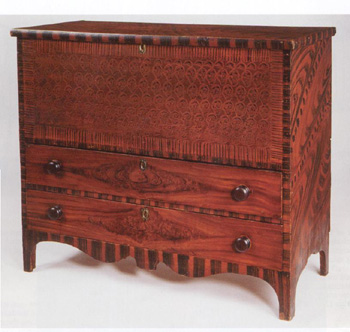Painted Blanket Chest
One of my Southern clients expressed strong interest in Lot #102 at Skinner's (Massachusetts) June auction. With a pre-sale estimate of $40,000-$60,000, you can well believe the "Painted and Grained Chest Over Drawers" had more than one thing going for it. It was in near mint condition. At only 35.5" wide, 17" deep and 41" tall it was petite in size and nicely proportioned. It bore an important handwritten signature, "Solomon Garfield 1840," possibly the maker. The blanket chest's most outstanding feature, however, was evident in the color picture provided in the Skinner catalog. It was decorated in a magnificently applied surface of red and black folk art paint.

Despite these attributes, at the bidding levels anticipated by the gallery, I said, in a phone conversation with my clients, "I think we should pass." "Why?" they said. "Is there anything wrong with the piece?" "No," I replied. "It's in pristine original condition. In a way, it's a masterpiece. It just doesn't hit me." My customers were perplexed. They have an appreciation for quality American furniture and folk art that borders on addiction. And they need a chest in which to store their socks and undergarments. Lot #102 had seemed to have it all. My statement of the piece "not hitting me" didn't seem to suffice."I think we should go after lot #151 instead," I suggested, trying to win back their encouragement. Lot 151 was a folk art painted blanket chest much like lot 102. Except that it was a miniature example-something like a cabinetmaker might carry along with him for displaying his talents. And more importantly, it had an original coat of blue vinegar over soft yellow paint. This was even more striking than black over red. After pointing out the obvious fact that not a single t-shirt nor more than a single pair of balled socks could be stored in an 8" tall chest, even if it did have blue paint, my customers inquired as to the estimate. "Eight-hundred to twelve-hundred dollars," I said. "It will be a bargain at three times that level." "Go for it!" they told me.
Early American's, Canadians and Europeans lived in a much more colorful world than we surmise. While our old homes are mostly repainted white and the majority of our antique furniture has been stripped down to the bare wood, our forefathers and mothers were not afraid of vibrant paint. Paint is a combination of a liquid vehicle like milk, water or linseed oil, a pigment like indigo and, especially in non-oil-based paints, a binding agent like vegetable gum that will cause the paint to adhere to surfaces and bind when it dries. Employing various paints and just as important, artistic techniques, early artisans often transformed their mundane non-hardwood country furniture into works of art; furnishings that breathed life into their homes.
Notice that the pictured pine and poplar wood Solomon Garfield chest has been "grain-painted" in such a way as to simulate more expensive rosewood on the sides and mahogany on the drawer fronts. Silhouette surfaces are more boldly decorated. Here the artisan "comb-painted" red and black in tiger-like stripes. The upper façade is "sponge-decorated" in a variation of traditional faux painting now often referred to as "vinegar painting." Instead of using a vehicle with a strong binder in it for his black over-paint, the painter, who usually mixed his own paints, used stale beer or vinegar for his vehicle. Now the second coat had characteristics so that it could be "walked" over the ground color. After covering the dried red base with black vinegar paint, the furniture decorator artistically dotted the surface, probably with a small sponge or rolled strip of leather. Some of the wet top layer paint was lifted. The remaining black took up residence in the artful pattern still evident today. Upon drying, the sponge-decorated upper façade was permanently sealed with a binding layer of clear varnish or shellac.
The full size blanket chest in red and black paint sold for $43,700-a good buy. It might have brought twice that figure if the artist had not simulated wood so expertly. More than proficient simulation of high-priced hardwood, folk art collectors like paint that kind of jumps out at you from across the room. They like pizzazz in their original surface.
The early 19th century miniature chest in bold blue-green sponge-decoration exceeded its estimate by a factor of thirty-hammering out at a whopping $32,200! I, bidding on commission for my friends and clients, did not come close to winning it. There are those out there who can afford a lot more pizzazz than we.
